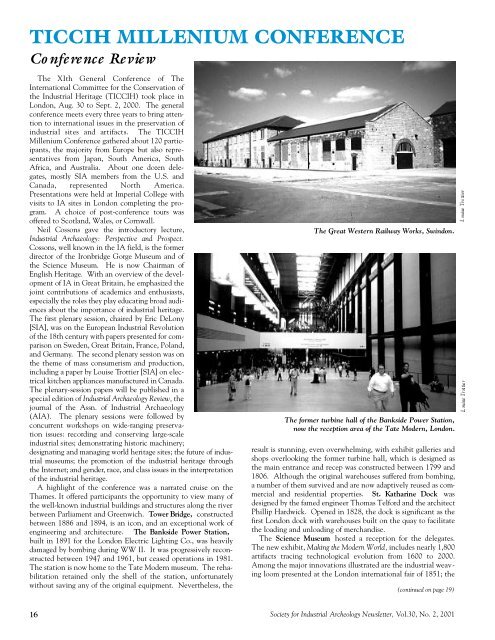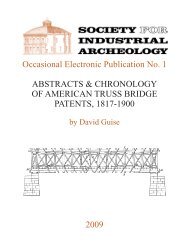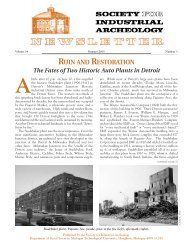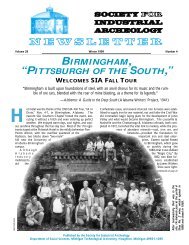RUHR, GERMANY - Society for Industrial Archeology
RUHR, GERMANY - Society for Industrial Archeology
RUHR, GERMANY - Society for Industrial Archeology
You also want an ePaper? Increase the reach of your titles
YUMPU automatically turns print PDFs into web optimized ePapers that Google loves.
TICCIH MILLENIUM CONFERENCE<br />
Conference Review<br />
The XIth General Conference of The<br />
International Committee <strong>for</strong> the Conservation of<br />
the <strong>Industrial</strong> Heritage (TICCIH) took place in<br />
London, Aug. 30 to Sept. 2, 2000. The general<br />
conference meets every three years to bring attention<br />
to international issues in the preservation of<br />
industrial sites and artifacts. The TICCIH<br />
Millenium Conference gathered about 120 participants,<br />
the majority from Europe but also representatives<br />
from Japan, South America, South<br />
Africa, and Australia. About one dozen delegates,<br />
mostly SIA members from the U.S. and<br />
Canada, represented North America.<br />
Presentations were held at Imperial College with<br />
visits to IA sites in London completing the program.<br />
A choice of post-conference tours was<br />
offered to Scotland, Wales, or Cornwall.<br />
Neil Cossons gave the introductory lecture,<br />
<strong>Industrial</strong> Archaeology: Perspective and Prospect.<br />
Cossons, well known in the IA field, is the <strong>for</strong>mer<br />
director of the Ironbridge Gorge Museum and of<br />
the Science Museum. He is now Chairman of<br />
English Heritage. With an overview of the development<br />
of IA in Great Britain, he emphasized the<br />
joint contributions of academics and enthusiasts,<br />
especially the roles they play educating broad audiences<br />
about the importance of industrial heritage.<br />
The first plenary session, chaired by Eric DeLony<br />
[SIA], was on the European <strong>Industrial</strong> Revolution<br />
of the 18th century with papers presented <strong>for</strong> comparison<br />
on Sweden, Great Britain, France, Poland,<br />
and Germany. The second plenary session was on<br />
the theme of mass consumerism and prod u c t i o n ,<br />
including a paper by Louise Trottier [SIA] on electrical<br />
kitchen appliances manufactured in Canada.<br />
The plenary-session papers will be published in a<br />
special edition of <strong>Industrial</strong> Archaeology Review, t h e<br />
journal of the Assn. of <strong>Industrial</strong> Archaeology<br />
(AIA). The plenary sessions were followed by<br />
concurrent workshops on wide-ranging preservation<br />
issues: recording and conserving large-scale<br />
industrial sites; demonstrating historic machinery;<br />
designating and managing world heritage sites; the future of industrial<br />
museums; the promotion of the industrial heritage through<br />
the Internet; and gender, race, and class issues in the interpretation<br />
of the industrial heritage.<br />
A highlight of the conference was a narrated cruise on the<br />
Thames. It offered participants the opportunity to view many of<br />
the well-known industrial buildings and structures along the river<br />
between Parliament and Greenwich. Tower Bridge, constructed<br />
between 1886 and 1894, is an icon, and an exceptional work of<br />
engineering and architecture. The Bankside Power Station,<br />
built in 1891 <strong>for</strong> the London Electric Lighting Co., was heavily<br />
damaged by bombing during WW II. It was progressively reconstructed<br />
between 1947 and 1961, but ceased operations in 1981.<br />
The station is now home to the Tate Modern museum. The rehabilitation<br />
retained only the shell of the station, un<strong>for</strong>tunately<br />
without saving any of the original equipment. Nevertheless, the<br />
The Great Western Railway Works, Swindon.<br />
The <strong>for</strong>mer turbine hall of the Bankside Power Station,<br />
now the reception area of the Tate Modern, London.<br />
result is stunning, even overwhelming, with exhibit galleries and<br />
shops overlooking the <strong>for</strong>mer turbine hall, which is designed as<br />
the main entrance and recep was constructed between 1799 and<br />
1806. Although the original warehouses suffered from bombing,<br />
a number of them survived and are now adaptively reused as commercial<br />
and residential properties. St. Katharine Dock was<br />
designed by the famed engineer Thomas Tel<strong>for</strong>d and the architect<br />
Phillip Hardwick. Opened in 1828, the dock is significant as the<br />
first London dock with warehouses built on the quay to facilitate<br />
the loading and unloading of merchandise.<br />
The Science Museum hosted a reception <strong>for</strong> the delegates.<br />
The new exhibit, Making the Modern World, includes nearly 1,800<br />
artifacts tracing technological evolution from 1600 to 2000.<br />
Among the major innovations illustrated are the industrial weaving<br />
loom presented at the London international fair of 1851; the<br />
(continued on page 19)<br />
16 <strong>Society</strong> <strong>for</strong> <strong>Industrial</strong> <strong>Archeology</strong> Newsletter, Vol.30, No. 2, 2001






